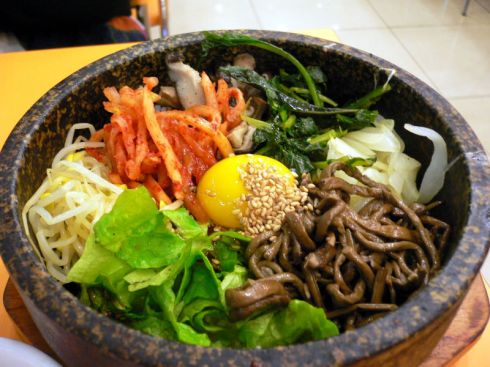Intro
Inspired by today’s lunch menu, in which everyone was bum-rushing to get into our cafeteria, I want to tell you a bit about Bibimbap (비빔밥).
Traditionally, Bibimbap consists of a bowl of warm white rice topped with namul (나물 sautéed and seasoned vegetables) and gochujang (고추장 chili pepper paste). A raw or fried egg and sliced meat is usually added. It is usually thin pieces of beef. The ingredients are then stirred together thoroughly just before eating. It can be served either cold or hot, I think I would personally prefer hot with less than the mass amount my teachers tend to pile on their plate. Bibimbap literally means “a mixed meal”. Bibimbap contains all the nutrition that is needed for a complete meal.

History
Siuijeonseo (시의전서), a cookbook compiled in the late 1800s, includes the first-ever reference to bibimbap. The author is officially unknown but there are speculations that it would have been a woman of nobility who created the book. She would have been part of the yangban (양반). The yangban were part of the traditional ruling class or nobles of Korea during the Joseon Dynasty. In these records, bibimbap is also referred to as bubuimbap (부븸밥) and goldongban (골동반). As gol means ‘disorderly’ and dong means ‘mix,’goldong refers to thoroughly mixing different things together. Therefore, goldongban is a reference to rice combined with various side dishes or ingredients in a bowl.
There are three main theories as to its origin according to this article:
- The first states that it was a royal dish prepared for the King as a light snack whenever he was hungry between meals.
- The second claims that it was a staple peasant dish during the farming season.
- The third says that it was born in the Donghak uprising in 1894 when the peasants who revolted had to mix their vegetables and rice together in one bowl because they didn’t have enough plates or bowls to serve the vegetables as a side dish
I first had it in Jeonju, famous for its bibimbap. We had our EPIK orientation there and introduced us to the dish. According to records, people started to eat bibimbap in Jeonju two hundred years ago. Jeonju bibimbap owes its popularity to perfectly steamed rice topped with freshly cut vegetables (10 different ingredients in Jeonju) combined with the excellent cooking skills of the local women. Also Jeonju is where the Joseon Dynasty began.
In 2002, Jeonju went as far as creating a research center to further globalize bibimbap.
“This research center aims to provide new Bibimbap making, packaging, cooking and preserving processes so it can be consumed by a wider public throughout the international world. This research center also will embark on promotional marketing projects to globally publicize the taste and history of bibimbap, in collaboration with the Jeonju Bibimbap Globalization team.”
In the News:
Welcome to the fusion of America and Korea…….The Bibimbap Burger! :
Interestingly enough, as I sat on my desk digesting my big meal, a teacher passed along this article from The Korea Times about a new burger in my very own NYC that fuses together two very signature dishes. The American Burger and Bibimbap. A chef from the hit TV show “Top Chef”, Angela Sosa, has combined these two at her restaurant Social Eatz.
My Take On It
I‘m slowly growing fond of the dish. It has been a slow process. I grew up eating rice everyday, than had an overload on a trip to Mozambique where we gorged on it for lunch and dinner for about two weeks. Needless to say, rice isn’t on my top fav foods list. Perhaps I will soon try Dolsot Bibimbap (돌솥비빔밥), served in an extremely hot stone bowl that cooks the rice to a crisp on the bottom and edges. That may just get my appetite going!
I leave you with this beautifully made video that promotes Korean culture and Bibimbap!








Recent comments